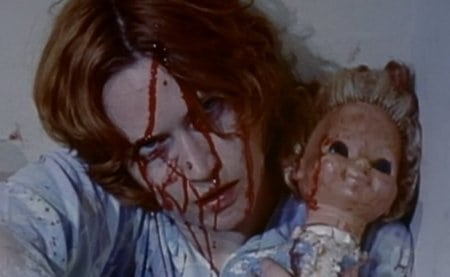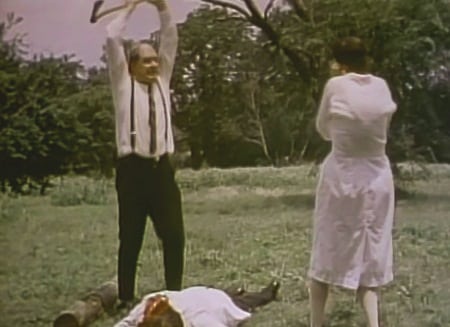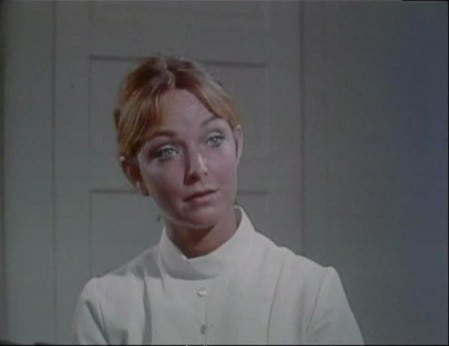Don't Look in the Basement, The Forgotten (1973)
Directed by: S.F. Brownrigg
Written by: Tim Pope
Starring: Bill McGhee, Jessie Lee Fulton, Robert Dracup, Rosie Holotik
Don’t Look in the Basement (AKA The Forgotten) (1973)
First released: 1977
Director: S.F Brownrigg
Current UK Status: Passed 15 uncut
Don’t Look in the Basement was first released in UK cinemas in 1977, but started life as a drive-in movie double bill with Wes Craven’s The Last House on the Left in the early seventies in the US. The UK cinema release was cut, and then in 1983 an even shorter version was released by Crystal video, and it is thought that this was a TV version of the film. At the height of the Video Nasty craze, Don’t Look in the Basement was added to the list in August 1984. It did not last long, and in December 1985 it was quite rightly removed from the list. However, the film was still cut, and it was not until 2005 when it was released on Stax DVD that the BBFC waived its previous cuts, and the film was granted a 15 certificate uncut. The film has since been re-released on a number of different labels, each with the same uncut version.
Director of Don’t Look in the Basement, S.F Brownrigg, only made five films in a career that ran from 1973 to 1986. However, he was well known for making good quality horror flicks on a micro budget. Often using a cast of relative unknowns, he would get some impressive acting from his actors, and this was helped usually by cleverly written plots that offered fans new and exciting surprises. His films were also known for their murky, dirty atmosphere and sudden bursts of brutal violence, and if you really want to know exactly the sort of film Brownrigg made, then look no further than Don’t Look in the Basement, his debut feature.
Born in El Dorado, Arkansas on 30th September 1937, Brownrigg passed away in Dallas, Texas on 20th September 1996. He started his film career while serving in the army, and during this time he worked on a number of army training videos while also working as a combat photographer. He met fellow filmmaker Larry Buchanan in 1955, and the pair worked together on a number of films including The Naked Witch, The Eye Monster and Mars Needs Women. Brownrigg edited and worked on the sound for a number of the films they collaborated on, and went on to become head of the sound department at the motion picture lab Jameson Film Company. 1973 saw the directors first film, Don’t Look in the Basement, become a drive-in movie favourite, and for the next thirteen years he directed a further four sleazy, low budget horror flicks including Poor White Trash 2 (1974), Don’t Open the Door (1975), Keep My Grave Open (1976) and Thinkin’ Big (1986). Brownrigg often produced his films, and Poor White Trash 2 was voted the ‘worst movie of all time’ by a reviewer for the Michigan Daily. His film career came to an end in the mid eighties, and Brownrigg moved on the working on TV shows including golf shows for ESPN, hunting and fishing programmes. Brownrigg also became the president of the Dallas production facility Century Studios.
Don’t Look in the Basement is the horror film version of One Flew Over the Cuckoo’s Nest, as it is based entirely in a home for mentally disturbed patients. Here the patients are encouraged to clean and do other daily chores, and no locks are on the doors as to give a sense of “family” among the residents. This trustworthy but dangerous approach is the idea championed by Dr Stephens (Michael Harvey) whom we meet briefly at the beginning. I say briefly because as the head nurse is trying to ask him to leave (she’s had enough of the patients shouting at her you see!), Dr Stephens get killed by a patient. It is the first scene of violence, and will be the last for a good hour. Strangely though, the scene is more comical than unsettling, but that’s all part of these low budget horrors charm. Dr Stephens is getting a patient, who believes he is still a Judge, to let out his anger on a tree stump with an axe. Now, you could argue that the situation asked for it, but it makes for great viewing. Dr Stephens bellows at The Judge “reach for it Judge!!!” as we witness a grown man pathetically smashing up a piece of tree with vicious intent in his eyes. Turning his back on the patient to tell the nurse she can’t leave, Dr Stephens is hacked in the back and killed. The Judge attempts to attack the nurse and she hilariously screams for her life.
Welcome to the relaxed house of mental patients, where the patients roam free and can pretty much do what they want. The colourful collection of characters include Sgt Jaffee who believes he is still at war and is holding a prisoner in his room, a woman desperate to be loved, a simple black man named Sam (Bill Mghee) who believes nurse Jane is his Mother, another lady who believes a doll is her daughter and a man who finds it hilarious to take that doll, and among the rest of the gang is The Judge and some totally crazy old lady who later has her tongue cut out. Providing some of the films hilarious highlights, the old lady mumbles and sings throughout the film, often singing “up the misty mountains, down the running glen” and then waffles on about warnings of men, and to “get out!” The characters are soon to come under the care of a new nurse, Charlotte Beale (gorgeous Playboy model Rosie Holotik) or should that be Charlotte come under the care of the patients! They welcome her in, some a little more than others, and while she is hesitant, Charlotte goes about caring for the “family”
All seems well as Charlotte settles in to her newly formed daily routine, something which is laid down in the rule book read out by Nurse Jane. It would seem that playing out the patients delusions is the best way to cure them, so it is accepted that the doll is a real baby, the Sgt gives his orders and the Judge walks around judging everyone. It is funny, sweet and enjoyable to watch, and you almost get used to the idea and forget you are watching a horror. This feels more like a drama, a study of madness played by actors all doing a magnificent job of acting a little ‘mental’. However, signs of darker times ahead come from a visit by the “telephone man” who has arrived to fix the telephone. He meets the Judge and the old lady and genuinely believes they are normal people, until he says the wrong thing and it becomes clear they are a little unhinged. Clever writing on Tim Pope’s (the screenwriter) part as we actually start to forget these people are mad, and we can totally understand how easily fooled the telephone man was. Other signs come from The Judge getting angry when told to clean his room, Nurse Jane making him hold a piece of paper on fire as punishment, the woman with the doll attacking Nurse Charlotte and a number of others instances. Poor Nurse Charlotte just may have her work cut out for her?
The film plods along at a slow but rewarding pace for its time. See, films didn’t move as quickly as they do these days back then, and as such a film like this needed to rely on a good story and strong characters, and it has that. It may become a tad slow and tiresome in places, but overall Don’t Go In the Basement is very satisfying in its pacing and story build up. However, there is an intense sting in the tail just before the final third act, and we find Charlotte in a whole heap of trouble as the film delivers its violent and quite clever climax. Watching this film you must remember that plot twists were not as common place as they are these days, and so what follows in this films plot is a very clever move indeed. Granted it might not have the same effect today as it did back then, but for all its worth, it is a stroke of genius.
Then we have the final moments where the film gained most of its notoriety from. A violent, savage climax for its time, and made all the more upsetting due to the fact we have just spent the entire film getting to know these characters and trying to understand them. They were harmless, and seeing what happens is actually quite shocking. Camera close-ups and an almost fly on the wall like approach to filming the violent scenes increase the level of savagery, and the clever editing means that the lack of special effects were well hidden. Don’t Look in the Basement may not be violent all the way through, and it is more the shock of seeing those we have befriended turn into savage beasts which shocks, and thus makes for a rather rattling finish. A final kick in the teeth is the clever use of the final credits and the shots of the actors who played the parts. Whether it really justifies the film being added to the Video Nasty list, or even being cut, is debatable, but personally I felt the treatment was unnecessary. However, it certainly helped make the film one of the more well known on the list.
Rating: 









Should Don’t Look in the Basement have been added to the Video Nasties list? I suppose for all out shock factor it was pretty intense come the end, but the violence is very tame and quite brief, so no, it should not have been added to the list.






I have not seen it yet